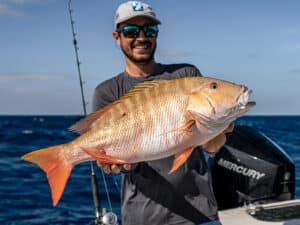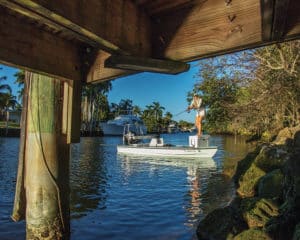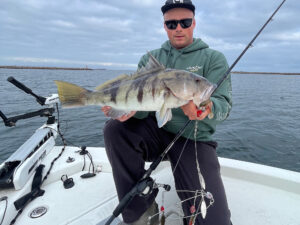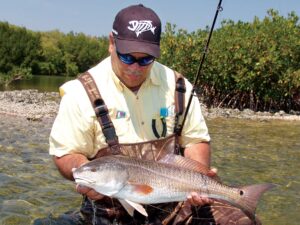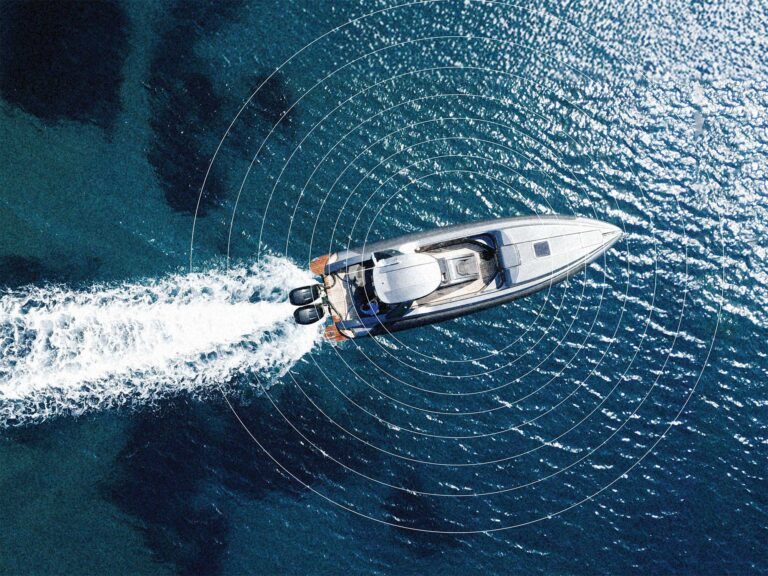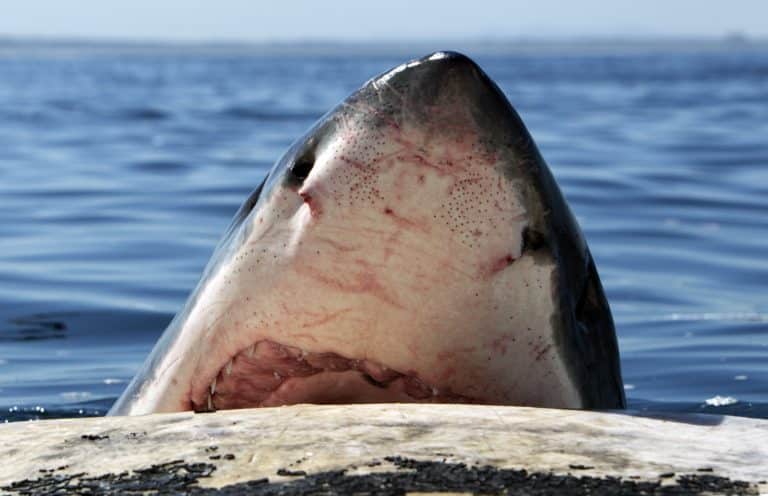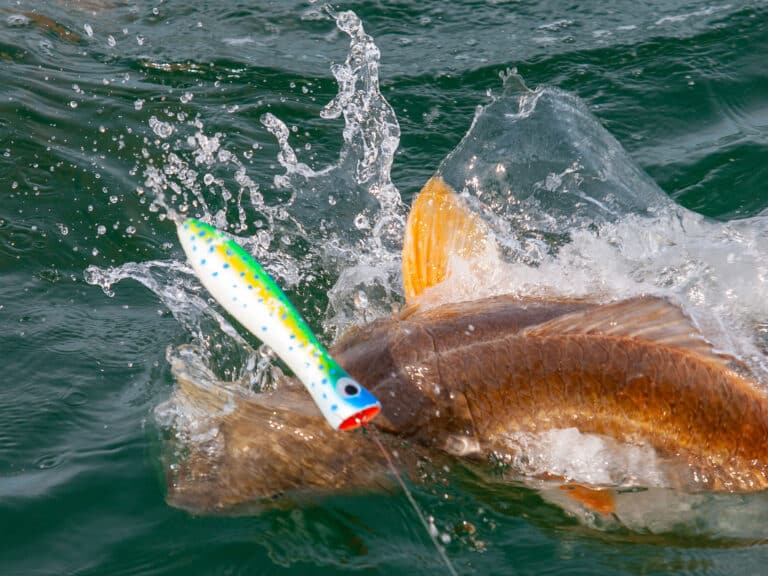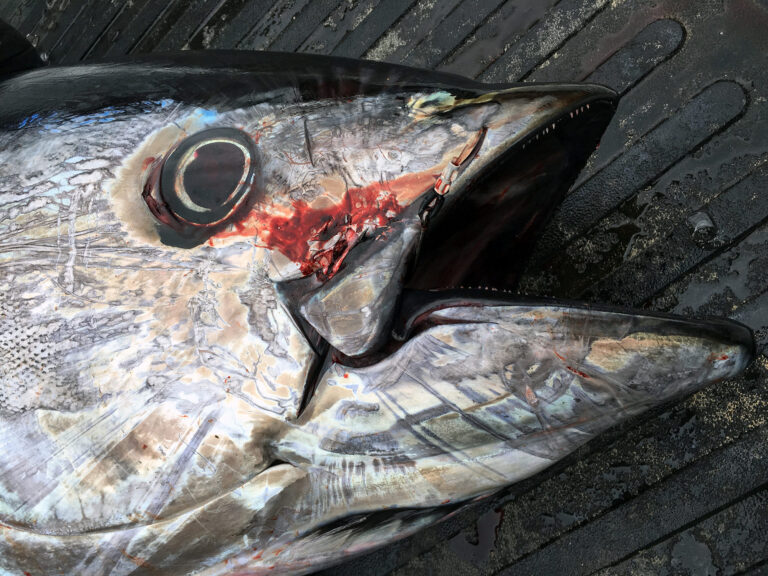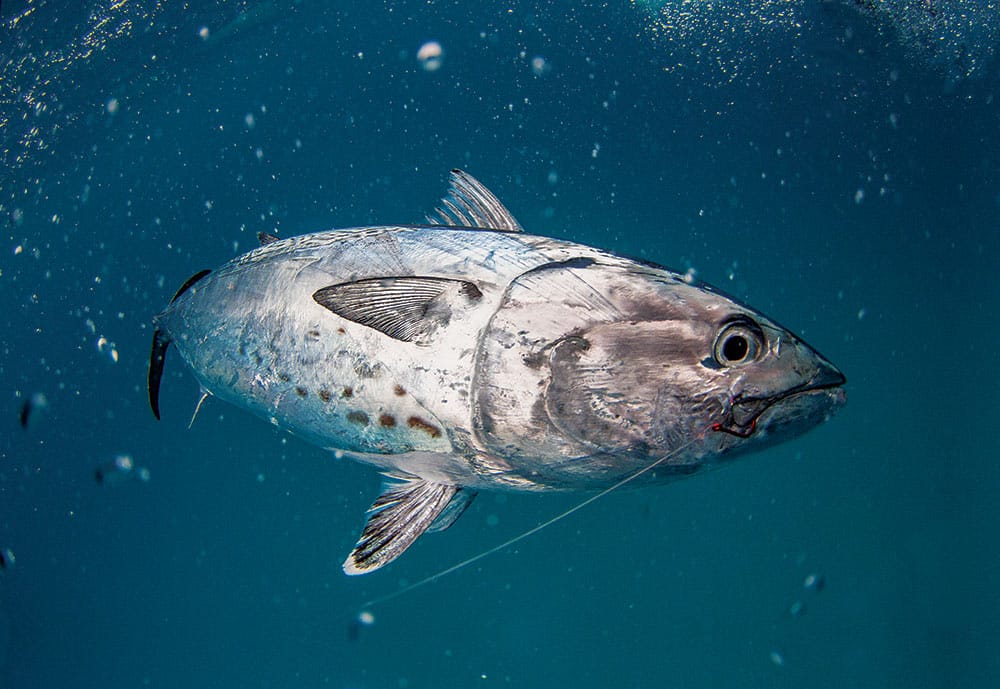
In the early 1990s I got my first look.
The wind honked out of the north on the first chilly day in September. It just felt fishy.
Running toward the birds, I thought at first the boils were stripers. But when the fish came up, I knew this was something different: Streamlined muscular fish with green backs slashed through baitballs at an ungodly speed.
Composure lost, heart pounding, adrenaline level through the roof, I made several casts, which went unnoticed. About an hour and 30 casts later, I finally came tight, and it felt unreal. Line peeled off the reel so fast I didn’t know what to do. I cranked down the drag a quarter turn and the reel literally blew up, falling to pieces on the ground.
Didn’t matter. I was hooked. This was well beyond anything I had experienced before. Straight-up tuna inshore. Mind blown.
False Albacore Allure
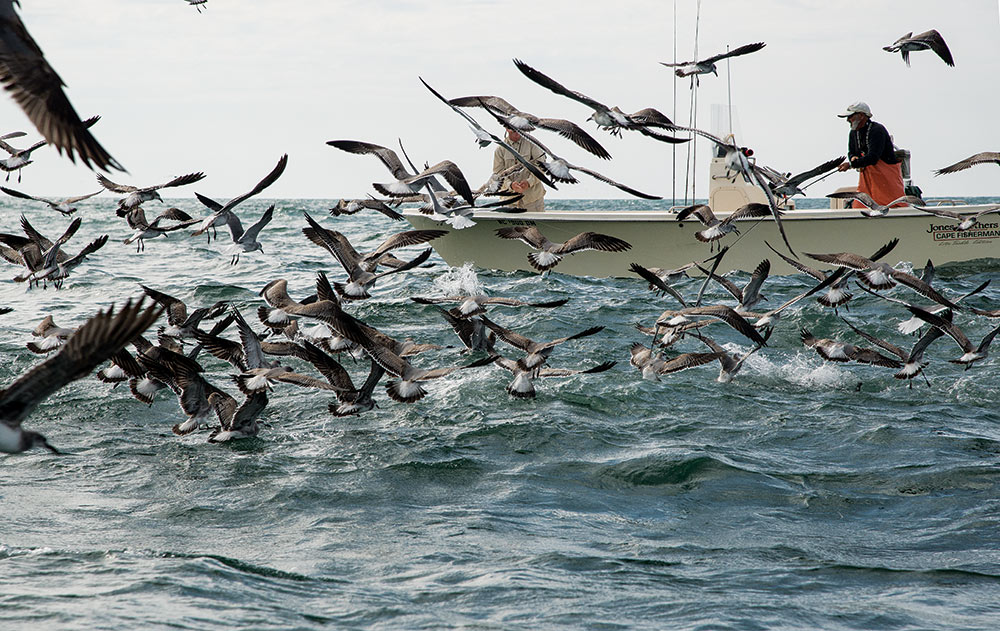
I am not alone. All along the coast, false albacore (technically, little tunny — also known as albies, bonito, fat albert, hardtails and funny fish) have been blowing inshore anglers’ minds, particularly those light-tackle advocates who favor sight-casting rather than trolling or bait fishing.
“They’ve developed a steady following up here,” notes Capt. Paul Dixon, of Montauk, New York. “We’ve got a fleet that thrives on their arrival every fall.”
That’s because they’re what many hardcore light-tackle anglers describe as the perfect quarry, offering an often awesome visual surface feed, a high but not impossibly high level of difficulty, and drag-burning runs that create instant memories. And for fly-fishers? Rarely do you catch one that doesn’t bring you into backing almost instantly.
“The visual element is unique,” notes Capt. Ian Devlin, of Connecticut, who characterizes albies as ram-induction feeders (consistent with tunas). They don’t just chase bait, they tear through it. “It’s a quick, spectacular burst and then they’re gone, and you’ve got to get up and run after the next pod.”
“It’s definitely about the hunt … the chase,” says Capt. Gene Quigley, of New Jersey. “That’s what makes it exciting.”
But albie fishing is more than just the high-adrenaline run‑and-gun. “My favorite part is seeing the look on a guy’s face when he first hooks up,” notes Capt. Doug Jowett, of Cape Cod. “These fish just go and go.”
The visual element is unique. It’s a quick, spectacular burst and then they’re gone, and you’ve got to get up and run after the next pod.
— Capt. Ian Devlin
Advertisement
“What we’re talking about here is access to a strong, fast pelagic,” says Dixon. “A straight‑up tuna, sometimes a stone’s throw from the beach.” And they can be caught with fairly light gear, including flies. In that context, the albie run is pretty extraordinary.
“They are challenging,” notes Capt. Brian Horsley, of North Carolina. Albies are notorious for being very finicky and boat shy. “Sometimes we fish ’em all day and only catch a few.” Indeed, you have to make good, fast casts under pressure. That takes skill and composure — of course, that’s part of the albie draw.
Because the schools generally show up around the same time and places each year, the anticipation builds. Anglers gear up in advance. And when the first albies show, word spreads like wildfire.
When and Where to Target the Fish
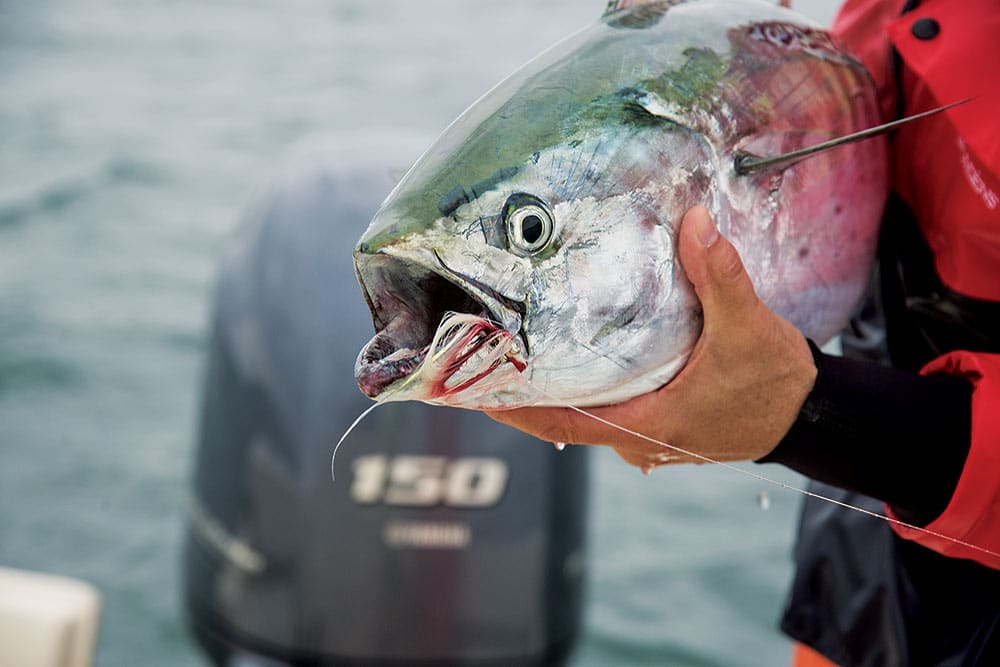
While false albacore certainly don’t generate the avid following in Florida that they enjoy in the mid-Atlantic and southern New England, the fish do swarm the Sunshine State during late spring and summer.
“The southeast wind brings them in,” says Capt. Dino Torino, of Jupiter, Florida. “We have them from late May through August.” It’s a different fishery, though: no running and gunning, or chasing fish. “You stay put, and chum them up.”
In southern New England and the northern mid-Atlantic, where undoubtedly most of the targeting occurs, albies can be found 20 to 40 miles offshore, in depths of about 180 feet, pretty much any time from June on, mixed in with other pelagics, such as skipjack, bluefin and yellowfin. Inshore — within a mile of the beach and in harbors and bays — they’re most certainly a fall-run fish.
“We catch a few in Nags Head [Outer Banks, North Carolina], in August,” says Horsley. “But we don’t really focus on them until they show in September off of Harkers Island [farther south, near Morehead City].”
These smaller fish, in the 5-pound range, generally appear right near the beach. As October approaches, bigger fish mix in. “November is when the real biggies show. … All fish over 18 pounds,” he says.
Moving north: Although albies are caught off Virginia, Maryland and Delaware, for some reason they don’t set up there, and thus few anglers focus on them. The fish anglers do encounter don’t seem to stay long, and are likely just passing through.
From central to northern New Jersey, the fish consistently set up, and that’s where anglers really start targeting them. “We have fish offshore a bit, on the lumps earlier,” says Quigley. “But inshore it usually happens in September, although it seems to be happening later and later every year.”
“November is when the real biggies show. … All fish over 18 pounds.”
— Capt. Brian Horsley
Off the Long Island side of New York Harbor, the migration appears similar. Ten years ago, a first run of fish might occur off Breezy Point, New York, in late August, and the numbers would escalate into September. But now, the fishery doesn’t seem to get going until October. “We’ve actually had pretty good runs in early November these last few years,” says New York Harbor Capt. Danny Reich.
Albies show up intermittently along Long Island’s south shore, but it’s really that area from Long Branch, New Jersey, to Breezy Point, New York, and inside New York Harbor that tends to hold the best concentrations of fish in the region.
Out east, false albacore tend to set up in some pretty specific locations. Shinnecock Inlet, New York, is a well-known albie spot, particularly for those fishing from the jetty.
And then there’s Montauk, possibly the best albie spot on the coast. They show up, sometimes in spectacular numbers, off of Montauk Point Lighthouse, and can be found crashing through bay anchovies at any point all the way west to town.
“Usually, someone sees them off of the point in August,” says Dixon. “But once September rolls around, they fill in and can be found in pretty good numbers all the way back to Plum Island.”
The North Fork of Long Island sees a good run too, and the entire Rhode Island and Connecticut coastlines host albies at some point. Cape Cod seems to be the northern version of Montauk, although less consistent. And we can’t leave out the fish that show off Martha’s Vineyard and Nantucket in September.
Fall Live Bait Blitz
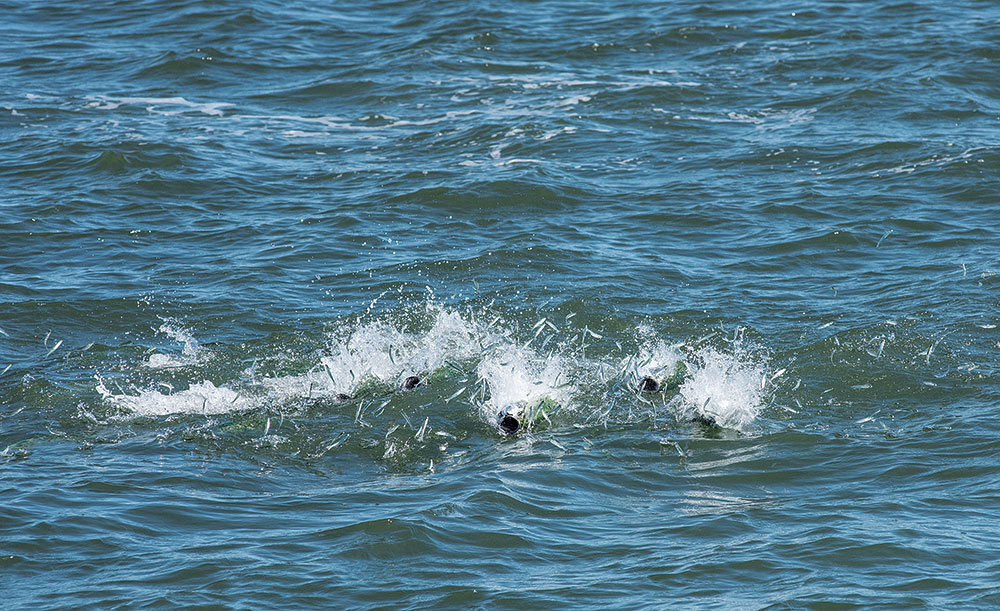
Where the albies show varies some year to year, but captains agree that bait generally drives the congregations.
Albies can be found feeding on many species: silversides, sand eels, juvenile menhaden, glass minnows, squid, small shrimp and crabs. Yet, without a doubt, the fish key in on bay anchovies in the mid-Atlantic. In Cape Cod, Martha’s Vineyard and Nantucket, they focus on sand eels.
“Yeah, they blitz on silversides, but for sure, they come into the Sound with the anchovies,” says Connecticut’s Devlin.
Bay anchovies usually measure 1 to 3 inches long, with a silver underbelly and a reddish, copper-colored back. The copper color only becomes obvious when the baitfish school up in the hundreds. Horsley calls them “red bait.”
These prey fish spend warmer months in the bays and estuaries of the mid-Atlantic. But the first cool night often signals an eastward migration in which they flood the inlets and beaches, bringing albies right up to the surf line.
“Montauk’s entire ecosystem revolves around bay anchovies,” says Dixon. “Some years we get sand eels, but anchovies create the big albie blitzes.”
The angle of your approach is real important. Turn the boat parallel to the fish so that after the cast, the angler can stay tight to the line.
— Capt. Gene Quigley
“Well, they certainly aren’t easy,” says Cape Cod’s Jowett. “Every once in a while, you’ll get a day where they feed recklessly, but the standard is you maybe catch a few.”
Whether you hook up or not is sometimes about the approach, says Horsley. “You’ve got to come in slow, off plane, making sure you don’t wash them out.” Indeed, big boats that push a lot of water seem to catch fewer fish than the smaller, lighter ones.
“The angle of your approach is real important,” says Quigley. “Turn the boat parallel to the fish so that after the cast, the angler can stay tight to the line.” Because they’re up and down so quickly, get the lure or fly moving as soon as it hits the water.
“Aggressive guys don’t help the situation,” says Dixon. “Running too fast spooks albies and breaks up the baitballs.”
It’s understandably hard for excited anglers to avoid chasing every pod of busting fish, but guys who take the wait-and-see approach score the high numbers. “Sure, I chase fish sometimes, but I also try and stay put, and look for patterns,” says Reich.
If you can calm down, observe and put yourself in the right place, you’re more likely to find yourself in the middle of a blitz rather than halfway down the beach following a pod that will sound before you can get there.
Patient anglers get bites by blind-casting too. “When crowds get bad, I go to points of land, depth changes, outflows or just areas I’ve noted bait concentrations, and we blind-fish,” says Devlin.
John Skinner, a New York angler and author of several books on surf-casting, notes that from shore, you usually don’t get shots at busting fish. “Just about every fish I catch is blind-casting. You really just need to find likely spots and then put in the time.”
False Albacore Lures and Tackle
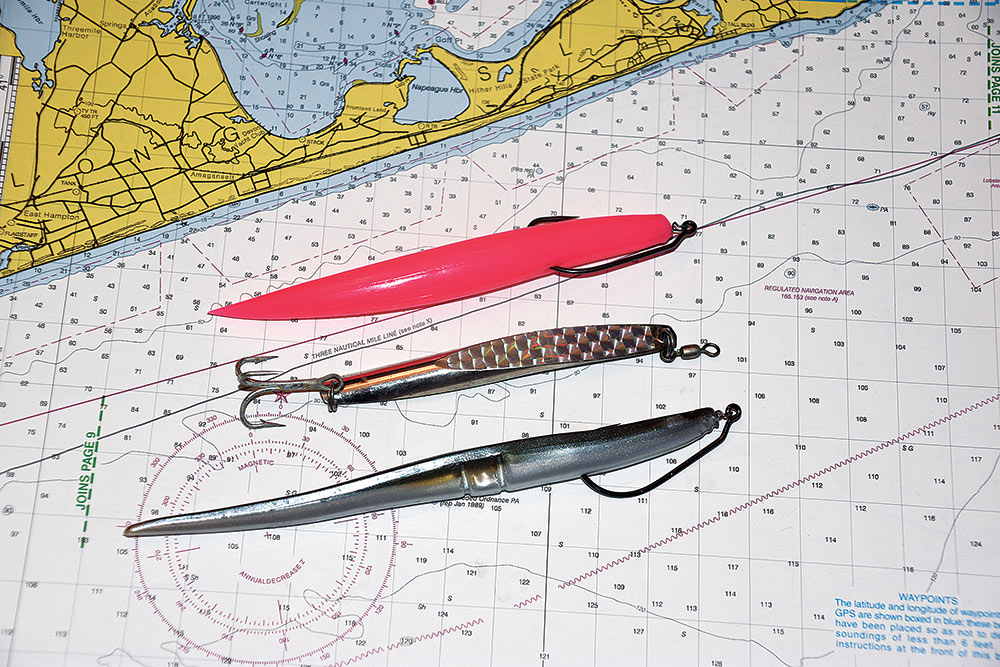
Because albies can be finicky, baits and their presentation count. Generally, you won’t get them with striper techniques.
The go-to albie lure for some time has been the Deadly Dick — locally called a tin, a small, slender metal lure with reflective tape — in the ½- to 3-ounce versions. For sure, it catches.
Skinner uses all sizes: the windier, the heavier. But he throws the 2-ounce version more than anything. “You gotta reel in as fast as you can,” he says. “You can’t out-reel them.”
Most of the strikes he describes as “spectacular,” right on the surface, as the tin skips across the water. “If you’re fishing them right, it’ll be too fast for stripers and bluefish.”
Boat anglers also use Deadly Dick lures. Their weight and wind resistance allows quick, long casts. However, any small, slender metal lure can catch fish; ones with reflective prismatic tape tend to work best.
On the other hand, the newest generation of albie anglers swears by soft plastics, such as a 6-inch pink or white Slug-Go-type bait. “It flies in the face of all of us match-the-hatch advocates,” says Reich. “But they do draw violent strikes.”
Soft plastics need to be worked much slower than metal, and with an erratic, twitching motion. If you want them to swim right, you also have to fish them on a weedless hook with no weight, which makes them tough to cast, particularly in any stiff wind. Albie Snax soft baits have developed a following. They’re heavier, so casting is less of an issue.
From a boat or the beach, most anglers use a 7-foot medium-heavy spinning outfit. While they aren’t terribly big, albies are quite strong. Choose a serious reel with a smooth drag, capable of carrying at least 250 yards of 20-pound braid. I’ve seen lesser reels blow up. Use 4 feet of 20- to 30-pound fluorocarbon for a leader.
For fly anglers, Bob Popovich’s “surf candy,” in tan or copper over white, and other epoxy bay anchovy patterns seem to work the best. However, in recent years, some have moved away from real colors to more flashy ones such as chartreuse and pink. Which flies work, and when, really depends on the mood of the fish.
Many anglers go with a 9-weight for tackle, but some move up to a 10 so they can land fish faster. The reel should feature a good drag system and hold at least 250 yards of backing with a clear intermediate fly line. Leaders vary, but a lot of guys simply use 6 to 8 feet of straight 20-pound fluorocarbon. For finicky fish, try 15-pound-test.
Don’t Eat the Albies
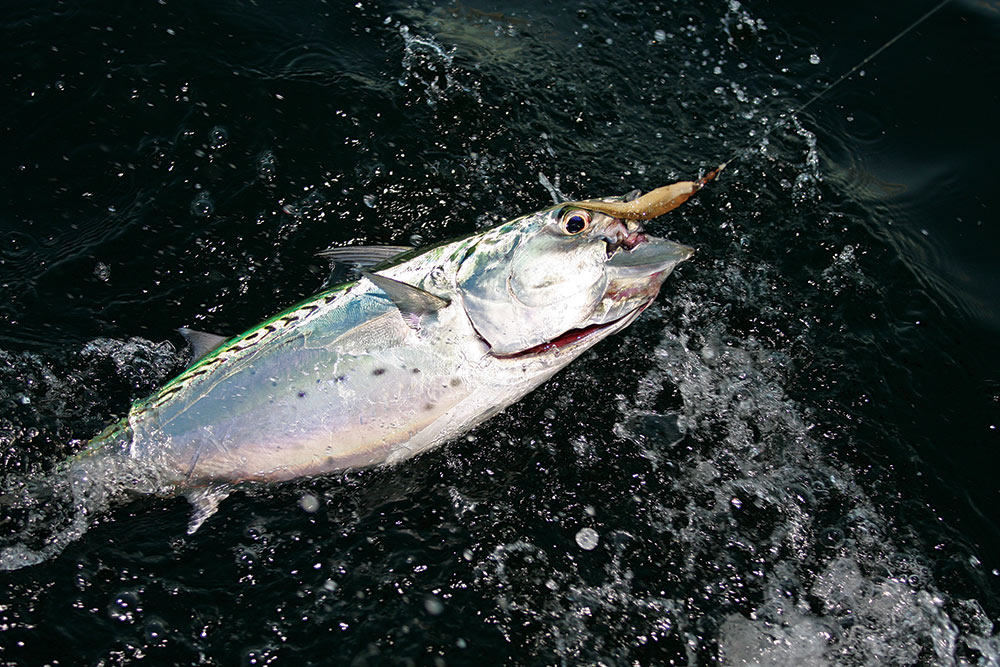
Up until the past several decades, false albacore didn’t garner much attention — from anyone. That’s likely because they’re mostly inedible.
I found that out the hard way when I brought one home and tried to cook a couple of pieces. The smell lingered for several days; my cat wouldn’t even eat it.
The meat on a false albacore is dark red. Some folks claim to eat it, but I can’t see how.
Such a trait might be a blessing. Nasty flavor could be the reason these fish remain so abundant and reliable inshore at particular times of the year. Some commercial pressure exists, but remains minimal, at least for now.
That leaves albie addicts an available source of their particular drug. From the surface feed to their hard, fast run, these fish keep us jonesing for more.
About the Author:
Capt. John McMurray is owner-operator of One More Cast Charters, in western Long Island, New York.

